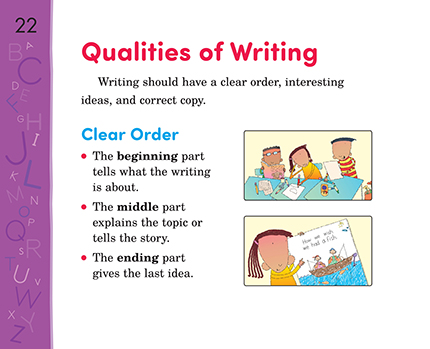Page 22 from

Start-Up Activity
Display for students a photo of a polar bear, lion, tiger, or some other large animal. Ask students what qualities make the animal special (great strength, size, speed). Then display a photo of something completely different, perhaps a popular food, and ask what qualities make it special. Next, point out that writing also has qualities that make it special: clear order, interesting ideas, and correct copy. Read about them on pages 22–23. Help students identify these qualities in a piece of writing, such as the student model on page 44.
Enrichment Activity: Throughout the school year, pay special attention to the qualities of writing during your discussions of stories and other forms of writing.
Think About It
“Ideas are like doors. It might just be a door that gets you to another door. But it might lead you to the secret door that opens up to the green meadow outside the castle.”
—Tomie dePaola

Start-Up Activity
Display for students a photo of a polar bear, lion, tiger, or some other large animal. Ask students what qualities make the animal special (great strength, size, speed). Then display a photo of something completely different, perhaps a popular food, and ask what qualities make it special. Next, point out that writing also has qualities that make it special: clear order, interesting ideas, and correct copy. Read about them on pages 22–23. Help students identify these qualities in a piece of writing, such as the student model on page 44.
Enrichment Activity: Throughout the school year, pay special attention to the qualities of writing during your discussions of stories and other forms of writing.
Think About It
“Ideas are like doors. It might just be a door that gets you to another door. But it might lead you to the secret door that opens up to the green meadow outside the castle.”
—Tomie dePaola